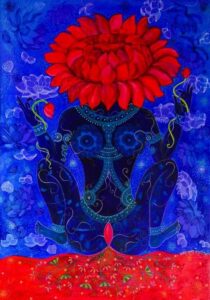“The vagina is Mahamaya and the penis is Sadashiva. Worshipping them, one becomes liberated while still alive, there is no doubt about it.”
(Yoni Tantra, Patala 5)
Yoni puja, or Yoni worship, is a ritual or religious practice rooted in Hinduism and Tantra. The word “yoni” is a Sanskrit term that refers to the female reproductive organ, specifically the vulva and vagina, and is often associated with the concept of the divine feminine. Yoni puja involves the veneration or worship of the yoni as a symbol of the goddess Shakti, who represents feminine energy and creative power in Hinduism.
This practice is considered a sacred and highly spiritual act, and it is generally conducted by Tantric practitioners or in specific Tantra traditions. It is not a mainstream or widely practised Hindu ritual, and its observance can vary depending on the specific tradition or sect. Yoni puja might involve offerings, chants, and other rituals to honour the divine feminine energy.
Yoni Tantra (4) we find:
“Worshipping this causes Shivoham. Listen, Parvati! Krishna, after worshipping Rada’s yoni, became God Krishna. Sri Rama Janaki Nath worshipped Sita’s yoni. Vishnu, Brahma, the saints, and I myself all were born from a yoni. What knowledge in the three worlds can match the magnificence of the yoni?”
YONI PUJA PROCESS;
Sanctifying of the 5 Elements: The five liquids are poured over the yoni. They represent the 5 elements. Generally, such libations represent offerings for the Goddess, but in this case the pouring of the 5 liquids over the yoni symbolizes the universalizing and sanctifying of the 5 tattvas (elements). The 5 liquids are collected in a vessel below the yoni symbol (in a case of a woman’s yoni, the vessel is placed below the thighs). The final mixture resulting from this libation is empowered by the direct and intimate contact with the Goddess. Every participant of a yoni puja will take a sip from this prasad (sacred offering).
The 5 liquids are Yogurt (Earth element), water (Water element), honey (Fire element), milk (Air element), and any edible oil (Ether element).
IMAGE CREDITS: 2023 NAVRATRI KAMAKHYA YONIPEETHAM PUJA
Note: Yoni puja performed with a woman’s yoni is known as stri puja or rahasya puja. There are some recommendations for choosing the woman for yoni puja because it is considered that the power of Shakti transmitted via the liquids to the devotees depends on the woman’s conscious transparency to the Goddess. That is why it is considered that the best choice for a yoni puja is a yogini. A yogini, by her power to channel the Goddess, creates the best conditions to raise the consciousness of those who take part in the ceremony.
“Devi is at the base of the yoni and Naganandini is in the yoni. Kali and Tara are in the yoni chakra, and Chinnamasta in the hair. Bagalamukhi and Matangi are on the rim of the yoni. Mahalakshmi (Kamalatmika), Shodashi (Tripura Sundari), and Bhuvaneshvari are within the yoni. By worshipping the yoni one certainly worships Shakti.” (Yoni Tantra, Patala 3)
SHIVOHUM or the experience of The self being as SHIVA is the ultimate blessing of a yoni puja practitioner. He arrives at the jivanmukta state of being fully liberated in this lifetime. This is the highest spiritual state and can be experienced only by the mature and veer saadhaka who can transcend lust and escalate to this higher consciousness by the divine practise of Yoni Puja.
Discover more from Dr Pallavi Kwatra
Subscribe to get the latest posts sent to your email.



